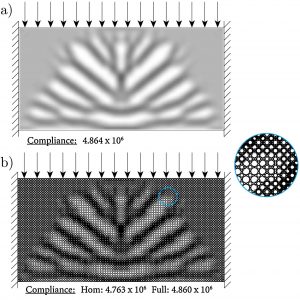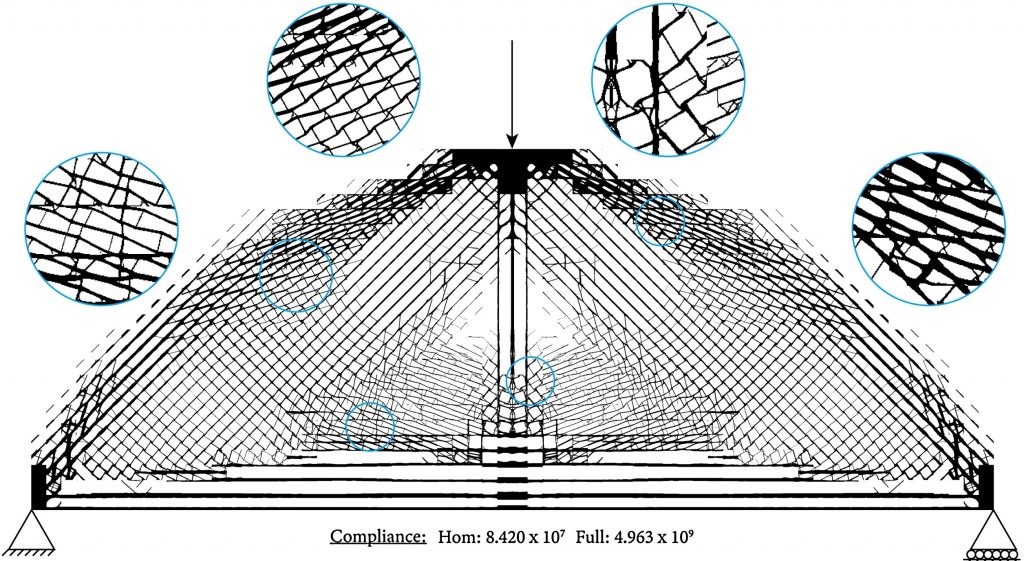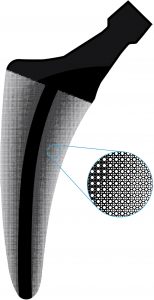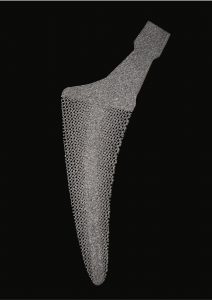Trabecular bone, also known as spongy or cancellous bone, is one of two types of bone found in the human body. It is found at the end of long bones, in the pelvic bones, ribs, skull and vertebrae. Trabecular bone is one of many microstructures with spatially varying properties found in nature. In a paper entitled “Compatibility in microstructural optimization for additive manufacturing,” a group of researchers points out that these microstructures can now be created by additive manufacturing. One challenge in the computational design of such materials is ensuring compatibility between adjacent microstructures. The researchers’ work aims to find the optimal connectivity between topology optimized microstructures.
“Given the fact that the optimality of connectivity can be evaluated by the resulting physical properties of the assemblies, we propose to consider the assembly of adjacent cells together with the optimization of individual cells,” the researchers explain. “In particular, our method simultaneously optimizes the physical properties of the individual cells as well as those of neighbouring pairs, to ensure material connectivity and smoothly varying physical properties. This idea is substantiated on the design of graded microstructures with maximized bulk moduli under varying volume fractions. The graded microstructures are employed in designing an implant, which is fabricated by additive manufacturing.”
When designing orthopedic implants, the researchers point out, it “may be desirable to have a continuous transition from denser microstructures in the central region to highly porous microstructures at the bone-implant interface.” This functional gradation promotes bony ingrowth at the bone-implant interface, they continue, while maintaining structural integrity and increasing mechanical properties in areas where bony ingrowth is not relevant.
The researchers presented a method of ensuring mechanical compatibility among topology optimized microstructures.
“Our results show that the bulk moduli of individual cells reach the theoretical bounds predicted by the Hashin–Shtrikman model, meaning that the optimization of compatibility does not compromise the performance of individual cells,” they state. “Furthermore, the bulk moduli of neighbouring pairs also agree well with the Hashin–Shtrikman bounds.”
 The method was extended to allow maximum length scale and isotropy in microstructures. The researchers demonstrated the effectiveness of their proposed method in a number of designs, including functionally graded materials and multiscale structures. They also showed that the optimized microstructures can be fabricated by additive manufacturing technology. This has implications for a number of applications, including orthopedic implants, which 3D printing can optimize for better growth of new bone.
The method was extended to allow maximum length scale and isotropy in microstructures. The researchers demonstrated the effectiveness of their proposed method in a number of designs, including functionally graded materials and multiscale structures. They also showed that the optimized microstructures can be fabricated by additive manufacturing technology. This has implications for a number of applications, including orthopedic implants, which 3D printing can optimize for better growth of new bone.
“As future work, we are particularly interested in the following aspects,” the researchers conclude. “Firstly, this method is directly applicable to 3D design problems. To alleviate the computational burden in 3D, the GPU-based topology optimization framework can be used. Secondly, while we have applied the compound formulation for maximizing bulk modulus, its applicability to other physical problems such as conductivity is left to be demonstrated.”
Authors of the paper include Eric Garner, Helena M.A. Kulken, Charlie C.L. Wang, Amir A. Zadpoor and Jun Wu.
Discuss this and other 3D printing topics at 3DPrintBoard.com or share your thoughts below.
Subscribe to Our Email Newsletter
Stay up-to-date on all the latest news from the 3D printing industry and receive information and offers from third party vendors.
You May Also Like
Printing Money Episode 17: Recent 3D Printing Deals, with Alex Kingsbury
Printing Money is back with Episode 17! Our host, NewCap Partners‘ Danny Piper, is joined by Alex Kingsbury for this episode, so you can prepare yourself for smart coverage laced...
Insights from Cantor Fitzgerald on AM’s Q1 2024 Landscape
A recent survey by Cantor Fitzgerald sheds light on the persistent challenges within the additive manufacturing (AM) industry in the first quarter of 2024. Based on responses from 38 industry...
3D Printing Financials: Xometry’s Scaling up and Strong Start to 2024
Xometry (Nasdaq: XMTR) kicked off 2024 with strong results, boosting its marketplace and technology to new heights. Both revenue and gross margin soared, fueled by an expanding global network of...
3D Printing Financials: Desktop Metal Targets Recovery Amid Net Losses and Revenue Downturn
Despite facing a decline in revenue and the persistent challenges of a tight economic climate, Desktop Metal (NYSE: DM) is making strides toward operational efficiency. The first quarter of 2024...



































